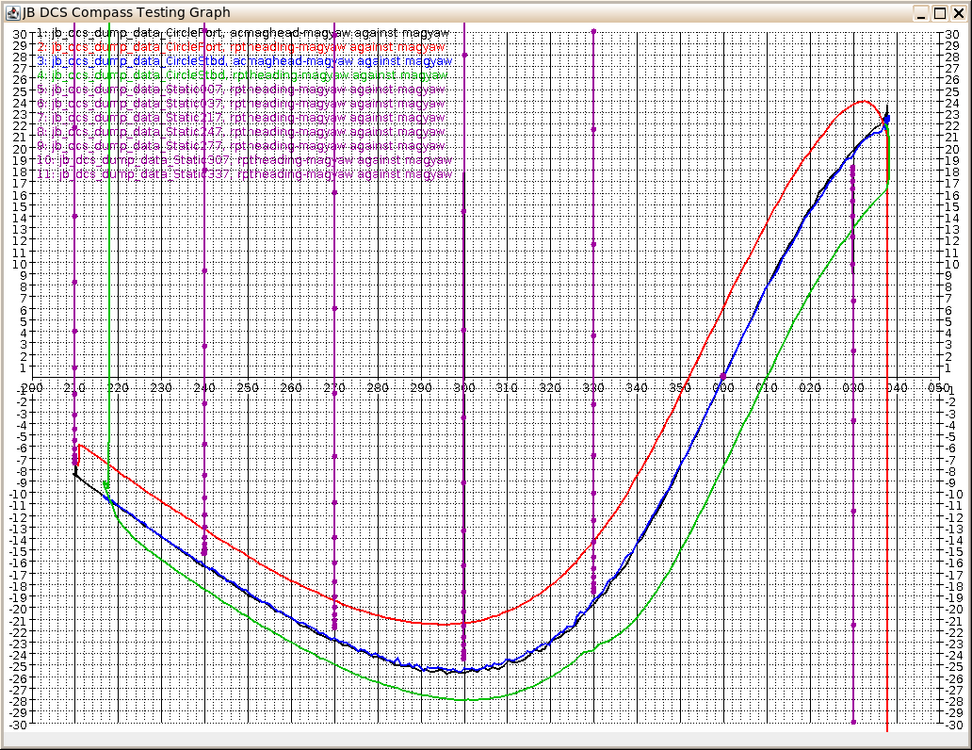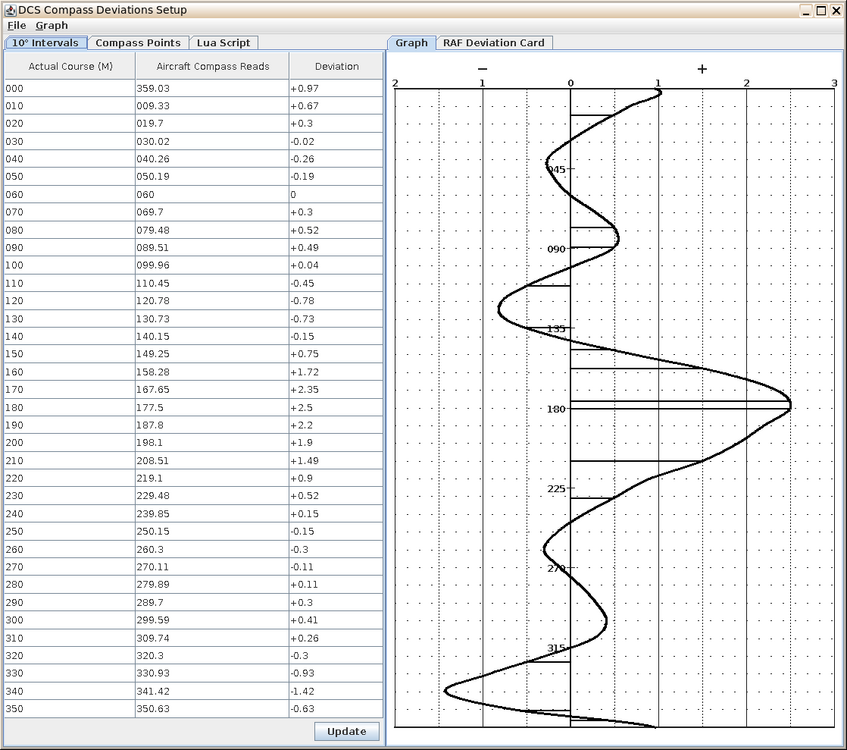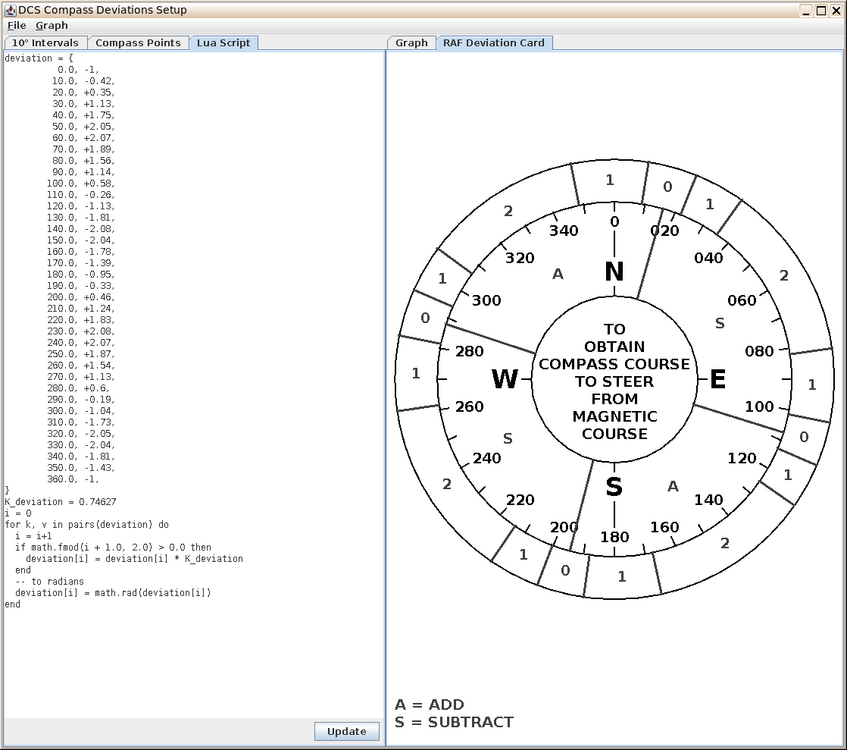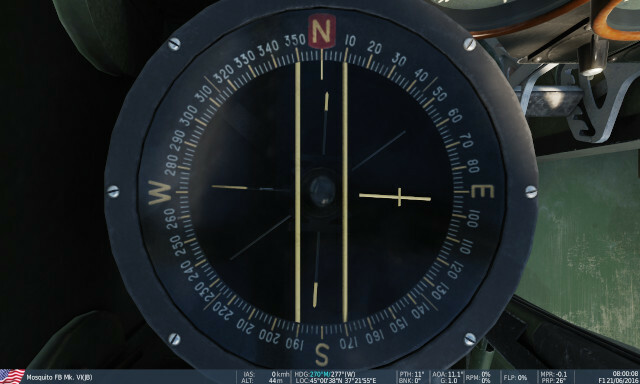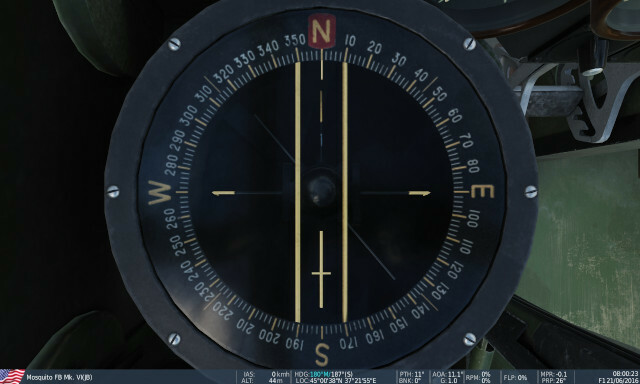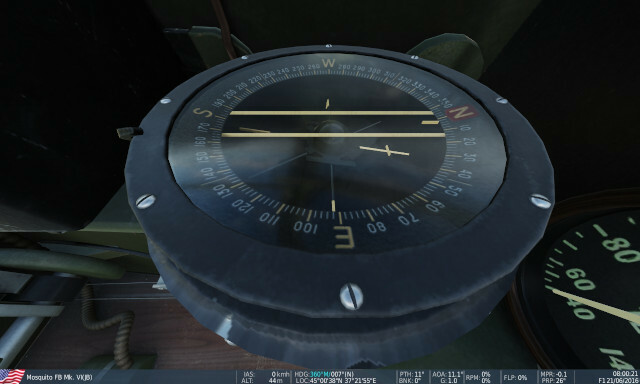

JBDCS
Members-
Posts
25 -
Joined
-
Last visited
Recent Profile Visitors
The recent visitors block is disabled and is not being shown to other users.
-

investigating Cannot calibrate Gyro with Mag Compass
JBDCS replied to Nealius's topic in Bugs and Problems
I've just checked in the setup files for the P-47 and the Spitfire. Those two both have pitch and bank correcting compasses in game - they have a max_pitch_bank setting in the setup file and details of the compass gauge pitch/bank/heading cockpit argument numbers towards the end of the file. For the P-47 the max_pitch_bank limit is 20 degrees and for the Spitfire it's 10 degrees, so the Spitfire may show some smaller errors if the pitch on the ground is more than that. For reference the setup files are: P-47: Mods/aircraft/P-47D-30/Cockpit/Scripts/compass_device.lua Spitfire: Mods/aircraft/SpitfireLFMkIX/Cockpit/Scripts/compass_device.lua These are similar to the P8M setup in the Mosquito, which like the Spitfire had a 10 degree limit set up (in Mods/aircraft/MosquitoFBMkVI/Cockpit/Scripts/compass_device.lua) - unsurprising since it's the same compass type. This still gives small errors on the ground since the aircraft is pitched up at 11.1 degrees, but much smaller than the errors being discussed in this thread. However the Mosquito repeater compass (Mods/aircraft/MosquitoFBMkVI/Cockpit/Scripts/repeater_compass_device.lua) behaves the same as the P-51 repeater, with large errors. Looking at the FW-190D9, that one (Mods/aircraft/FW-190D9/Cockpit/Scripts/Avionics/MagneticCompass.lua) does have a max_pitch_bank setting in it (of 20 degrees), but I think last time I tried that, which was admittedly a few years ago, it still gave the large errors despite having that line in there, and your post suggests that's still the case. Maybe it needs a fully-featured compass setup with pitch and bank corrections in the "gauge" table for the corrections to work properly, which the Spitfire, P-47 and the Mosquito P8M have - I'm really just guessing about that though. Hopefully we can get further comments or info from the devs at some point to clarify the situation. -

investigating Cannot calibrate Gyro with Mag Compass
JBDCS replied to Nealius's topic in Bugs and Problems
@NineLine In another thread about the compasses in the Mosquito (here) we've had a similar discussion, and the repeater compass in the Mosquito shows similar behaviour. In that case there's also a P8M compass in the cockpit which does adjust for pitch and bank (up to 10 degrees) and that compass shows a much smaller error due to the pitch nose-up on the ground, so the two compass readings are usually different (unless you're pointed to magnetic north or south). I did some testing to work out what the compass heading shown by the repeater was, and am reasonably confident that it's behaving as if fixed in the airframe with no gimbal or float to allow for pitch and bank. Whether this is realistic or not we're not sure about, but kablamoman's documents here suggest that at least for the P51 the repeater compass should have a pitch/bank allowance from the float. I think the repeater compass on all modules I've tested shows what I call the 'aircraft magnetic heading' (abbreviated to ACMagHead or acmaghead in my test results below). This is the magnetic heading obtained by setting up a vector in the magnetic field direction from the declination and inclination values, then rotating it to the aircraft coordinates by rotating through the heading, pitch and bank angles and taking the direction from the x- (forwards) and z- (starboard) coordinates. This is what I'd expect a simple compass fixed horizontally relative to the aircraft to read. Ie. it looks to me like the repeater compasses have zero allowance for pitch and bank. The maximum difference between this and the magnetic heading measured horizontally relative to the ground is indeed around 25 degrees for 12 degrees pitch. I've repeated these tests now for the P51 and put the results below if they're useful. To perform the tests I've first set the deviation figures to zero in Mods/aircraft/P-51D/Cockpit/Scripts/RemoteCompass_AN5730/compass_param.lua so that there are no deviations affecting the readings. I've then set up a hook script to log relevant data at intervals of approx. 4 times a second to a CSV file and set up a mission with a P51 on a parking area at Anapa with start type set to 'Take off from ground (hot)'. The mission date was left at the default which gives magnetic declination of slightly over 7 degrees east and inclination of 63.2 degrees. With this setup, I've run a number of static tests at fixed headings, where I set the heading in mission editor to 217, 247, ..., 337, 007, 037 giving magnetic headings of 210, ... 030 and left the aircraft static for a few seconds until the compass pointer is steady, then quit the mission and made a copy of the CSV data. I also run two dynamic tests where I taxied turning through around 180 degrees to port and to starboard, and again saved the CSV data. I'll attach tracks for the dynamic tests along with the script used to log the data at the end of this post. From the CSV data, I made up the following graph, which I'll attempt to explain below. All the plotted lines show the difference between a compass reading figure (calculated or measured) and the 'magyaw' figure, which is the horizontal (relative to ground) magnetic heading obtained from Export.LoGetMagneticYaw(). The blue and black plots are the 'ACMagHead' figure referred to above for the two dynamic (turning taxi) tests, which agree apart from small differences caused by changes in pitch because of ground bumps or uneven acceleration, etc. The vertical purple lines, with points shown, are the readings of the repeater compass from the static tests at various angles and show the repeater pointer moving to and settling on a reading at the mission start. The points are at approx. quarter second time intervals. As can be seen, they settle to a final value close to the calculated curve (within a degree or so, where the pointer damping stops the needle movement). The red and green plots show the repeater compass readings from the dynamic tests - turning to port (red) and starboard (green). As can be seen, they generally follow the calculated curve (except for a vertical line where the pointer is moving to its initial heading at mission start), but lag behind it since the pointer takes time to move to the new headings, so that when turning to port the reading is always a bit higher than the calculated heading and to starboard it is always a bit lower. I think these results support my assertion that it's the 'ACMagHead' figure that the repeater compass shows. Here are the tracks of the two dynamic tests: Testing_P51_GroundCirclePort.trk Testing_P51_GroundCircleStbd.trk and the hook script used to log the data (which includes the calculation of the ACMagHead figure): jb_dcs_dump_data.lua and here are the CSV files containing the logged data produced by the two dynamic tests: jb_dcs_dump_data_CirclePort.csv jb_dcs_dump_data_CircleStbd.csv -

investigating Cannot calibrate Gyro with Mag Compass
JBDCS replied to Nealius's topic in Bugs and Problems
I don't know if this is of interest, but here's a document I found when doing an internet search for info on the repeater compasses. It's a report from 1945 "Review of Remote Indicating Systems for Aircraft", covering various R.I. devices including compasses. I haven't read it in any detail, but it looks like there's some information on how flux gates were used at that time in it. https://reports.aerade.cranfield.ac.uk/bitstream/handle/1826.2/3199/arc-rm-2199.pdf?sequence=1&isAllowed=y [Edit: On having a look at it and searching for "flux gate", it's only mentioned with respect to one particular transmission method. Whether that's relevant to the repeater here I don't know. In fact it looks like it is, since it is the Magnesyn transmission method mentioned by kablamoman.] (Found this document, which is in the UK Cranfield University Aerade archive, via a link from a radio forum thread which the search turned up: https://www.vintage-radio.net/forum/showthread.php?p=1488845 Looks like there may be other interesting stuff in the Cranfield archive, but I've not had chance to look at it yet: https://reports.aerade.cranfield.ac.uk/) -

Looking for a real Mosquito compass deviation card, anyone?
JBDCS replied to Lau's topic in DCS: Mosquito FB VI
Thanks for the thread link kablamoman, I hadn't seen that thread but as you say it seems to be describing exactly the same problem in the Mustang (just from a quick look so far - I'll give it a proper read sometime soon). -

Looking for a real Mosquito compass deviation card, anyone?
JBDCS replied to Lau's topic in DCS: Mosquito FB VI
My guess would be no, not like that in reality, but since I don't really have any knowledge of it it's just a guess. -

Looking for a real Mosquito compass deviation card, anyone?
JBDCS replied to Lau's topic in DCS: Mosquito FB VI
Yes the R.I. Compass Repeater is certainly the easier instrument to read but one important note is that that one does read as if the compass it repeats from is fixed in the airframe and not gimballed at all, so with that one it's even more important to make sure you're flying dead level when reading the compass because without a gimbal the reading will be affected a lot by pitch and bank. For example in my test results detailed earlier in this thread for the P8M at various headings on the ground, with the aircraft pointed east or west there is a couple of degrees error due to the pitch up being more than what the compass can handle. For the repeater compass, this same test gives an error of more than 20 degrees in heading at 11 degrees pitch, which is what would be expected if it's fixed in the airframe. I've tried adding a max_pitch_bank line to that compass setup file, but it seems to have no effect, so looks like it's not that simple to set up. This is a bit strange when the DCS flight manual says during engine warmup to check that the P8M and repeater compasses agree and to set the gyrocompass from them, since on the ground as it is neither of them will usually read correctly and there will usually be a difference between their readings, often quite large. There's no information in the manual about the compass device which the repeater reads from, so no idea whether this is realistic or not, but someone will perhaps know more. -

Looking for a real Mosquito compass deviation card, anyone?
JBDCS replied to Lau's topic in DCS: Mosquito FB VI
Yes I agree, nice to get things right and great that the game/sim takes these things into consideration, but can any of us really fly that precise a heading? -

Looking for a real Mosquito compass deviation card, anyone?
JBDCS replied to Lau's topic in DCS: Mosquito FB VI
Okay, first off sorry I've not posted back for a while, I have continued testing things out though. The testing is very complicated (or maybe I'm overcomplicating it) because: it's very difficult to read the compass(es) accurately in the cockpit the readings are affected by pitch and bank as I've already mentioned the readings are also affected by inertia effects making the needle move around I've now worked out how to get the compass readings from the devices in game and log them to file along with the other heading information, so that fixes the first problem, but the other two still make things difficult. Anyway, by doing that and graphing out the differences between a setup with zero deviations and one with deviations set I think I'm reasonably happy that it is working how I expect (I'll put more details of that in another post sometime). So now that I've got that far, I've started work on a program for playing with the setups, and generated some deviation settings to simulate the readings for the Manchester in the 1944 RAF manual (p190). It's still very much work in progress, but the screenshots below should show what I'm aiming for, and at the end I've listed the deviation settings you could use in your scripts for these deviations (though I've not actually tested those settings yet). The first screenshot shows the deviations from the standard Mosquito compass_device.lua. These are the generic deviations which seem to be used across all modules in game. It shows the deviations against each course in steps of 10 degrees, along with a graph in the style of the RAF compass log graph on p191. The second screenshot shows the deviations for the Manchester, entered manually against the compass points, and adjusted for coefficient A (ie. the deviation figures match those in column vi in the manual), alongside the graph for those deviations. The only difference is that the table in the manual has north west first but my table has north first so that the rows line up roughly with the graph. The third screenshot shows the same data as the second, this time showing the deviations script which can be used in the device .lua files to set these deviations, and on the right a compass deviation card in the style of the card described also on p191. [Note: I realised after taking this screenshot that the deviation figures in the lua script are wrong - they should all be divided by the K_deviation value, since they're multiplied by it after that). I've fixed it now in the script at the end of this post, but this screenshot still shows the incorrect values. Also found that lua does not accept numbers beginning with +, so have removed those in the script too but again on this screenshot shows the old version.] (I haven't worked out yet how to suitably position the ADD and SUBTRACT labels, so for now the card just shows A or S.) The idea is that images of these graphs and/or cards can be added to the kneeboard or somewhere else. I'll also add the USAAF style deviation card from that manual (which is just a simple list) and maybe other formats later. Anyway, if you want to try playing with these deviations, here's the code you need to copy and paste into your compass_device.lua and/or remote_compass_device.lua files, replacing the similar existing code (but see the warning below this code): deviation = { 0.0, -1.34, 10.0, -0.56, 20.0, 0.47, 30.0, 1.52, 40.0, 2.35, 50.0, 2.75, 60.0, 2.77, 70.0, 2.53, 80.0, 2.09, 90.0, 1.53, 100.0, 0.77, 110.0, -0.34, 120.0, -1.52, 130.0, -2.43, 140.0, -2.79, 150.0, -2.73, 160.0, -2.39, 170.0, -1.87, 180.0, -1.28, 190.0, -0.44, 200.0, 0.62, 210.0, 1.67, 220.0, 2.46, 230.0, 2.79, 240.0, 2.77, 250.0, 2.51, 260.0, 2.07, 270.0, 1.52, 280.0, 0.8, 290.0, -0.26, 300.0, -1.39, 310.0, -2.31, 320.0, -2.75, 330.0, -2.74, 340.0, -2.42, 350.0, -1.92, 360.0, -1.34, } K_deviation = 0.74627 i = 0 for k, v in pairs(deviation) do i = i+1 if math.fmod(i + 1.0, 2.0) > 0.0 then deviation[i] = deviation[i] * K_deviation end -- to radians deviation[i] = math.rad(deviation[i]) end WARNING - If you edit the compass_device.lua files, they will fail the integrity check (you get messages in dcs.log about IC fail for those filename), so be sure to make a backup copy before editing them so that you can copy that back if you want to run on multiplayer servers which enforce the IC. I think this also means that your modified files will be moved to a backup folder when the game is updated and the files would revert to the standard ones, so you'd need to copy your modified version back into the game directory after updates. -

Looking for a real Mosquito compass deviation card, anyone?
JBDCS replied to Lau's topic in DCS: Mosquito FB VI
Sorry to correct your correction, but I think I was right in my guess, though it was just that at the time. I've had a bit of a look at that section of the 1944 RAF manual, and this covers it I think: "(a) From these eight deviations , calculate coefficient A. Loosen the compass fixing screws , and remove A by rotating the whole compass that number of degrees in the appropriate direction (clockwise if A is +, and vice-versa) . Re -tighten the screws. Coefficient A should be corrected only if of the order of 1 1/2° or more , and then only on the authority of the responsible navigation officer." So in their example, coefficient A is +3 so should be corrected by a compass rotation, to leave the column vi figures. -

Looking for a real Mosquito compass deviation card, anyone?
JBDCS replied to Lau's topic in DCS: Mosquito FB VI
Okay not read you full post properly yet (will do tomorrow), but unfortunately I don't think anything like the above paragraph is possible in game (if anyone can correct me, please do). The deviations are, I think, baked into the .lua scripts for the aircraft and loaded at mission start, so will be constant through the mission, and unchanged by dropping ordnance etc. As I say, I'd be happy to be proved wrong. No, no problem at all. That just means that with the generic profile it looks like they're using, the maximum compass deviation is 2.5 deg. You can make it as big or small as you want. -

Looking for a real Mosquito compass deviation card, anyone?
JBDCS replied to Lau's topic in DCS: Mosquito FB VI
Okay I've started a bit of testing now with the Mosquito on the ground. Not got as far as playing with compass deviations yet - I've got them set to zero for testing in my compass_device.lua script - but been investigating my comments a few posts up about how pitch and bank affect the compass. I'm glad to say that I was wrong in saying that the game works as if the compass was fixed in the airframe rather than floating - from testing with the Mosquito it looks like the pitch and bank do not affect the compass reading for small enough angles, so things are working as they should. This is controlled by another setting in compass_device.lua, max_pitch_bank = math.rad (10), which tells it the the first 10 degrees of pitch and bank are handled by the compass needle levelling, so should not affect the reading. However, the Mosquito on the ground is pitched up at 11.1 degrees, so there is still an effect seen on the ground when not aligned to magnetic north or south. I'll put some details of my testing in a spoiler below so people who are interested can have a look, but the short advice for Mosquito navigation based on the results is that you should only take note of the compass readings when you're within 10 degrees of level flight. It's good that DCS models the compass in this kind of detail. -

Looking for a real Mosquito compass deviation card, anyone?
JBDCS replied to Lau's topic in DCS: Mosquito FB VI
@average_pilot Yes I think I see what you mean, and it's one of the quirks of DCS terrain maps. The maps are set up on a rectangular grid, as usual in real maps, which doesn't necessarily align with true north (again as in real life). In our case the map north, which I call Grid North, as indeed they do on UK Ordnance Survey maps is the equivalent to our x and z coordinates in-game (y is the "up" coordinate, x is north and z is east). This is the grid and coordinates on the F10 map. The latitude/longitude lines can be shown/hidden in Mission Editor by going into the map options and toggling Geographical Grid, and from those you can see that the geographical (ie. true) north is aligned differently from grid north to different degrees at different points of the map. The ruler in Mission Editor and (I guess though not checked) the F10 map is simply based on the grid coordinates. The magnetic declination will also vary across the map. These can be obtained from a magdecl lua library, which will calculate and cache the magnetic declination and inclination for all latitudes/longitudes at any date, based on magnetic field models. I think in real life (though see note below) magnetic declinations are normally given relative to true north, but in game I'm pretty sure they're applied to the grid north. This means that if you fly a long way west-east or vice versa, true north in game will shift significantly, but the in-game grid north will not change and the magnetic declination will only change slightly. In real life, the magnetic declination would be applied relative to true north, so that would also shift in the same direction, which does not happen in game. Note 1: I just checked a UK OS map which was to hand (1:50,000) and in that case the magnetic declination IS given relative to grid north. However that's a walking map rather than a flying one, and the relative movement of true north across the map is likely very small, as opposed to a map covering hundreds of km / nm. When I get time I'll have a look at OS maps of different areas for the same date and see how they vary. The map key gives details of true north vs grid at each corner (in this case, grid north aligned with true on the western edge, and just under half a degree difference (true W of grid) at the eastern edge). Note 2: I need to do some experiments in game to check out the above claims - as I've said I experimented with various compass bearing tests in he past but not recently. I think it may be a good idea to start a new thread in a general section for discussions like this about magnetic compass navigation, where we can share info on how things work in real life and in game (but keep it free of various ADF/radio navigation info), because we're getting fairly off-topic I guess. Hopefully in the next few days I'll get chance to experiment and confirm (or otherwise) what I found last time I looked, and will maybe start a new thread and if so will post a link here. I guess (at least hope) this kind of thing is a big part of the projected 'Whole World Map'. Which makes me think of note 3 below: Note 3: I haven't tried any navigation stuff out in the southern hemisphere yet, eg. the South Atlantic map - got the map but hardly dare trying navigation out! Then there's the upcoming Kola Peninsula map for higher latitudes northern navigation. -

Looking for a real Mosquito compass deviation card, anyone?
JBDCS replied to Lau's topic in DCS: Mosquito FB VI
Looks like you can download an offline PDF of stuart666's 1944 manual here, in case you haven't found this yourself: https://www.google.co.uk/books/edition/Air_Navigation/WbJ8AAAAIAAJ?hl=en&gbpv=0 Not spotted any volume 2 though I'm afraid. Some different contents in this 1944 copy from the 1935 copy you linked to by the look of it. Thanks again to both of you for the links anyway, I've got lots to read now. I found this one by browsing the search results for Great Britain. Air Ministry in Google Books, lots of interesting stuff there (from the book link above, pick 'Search on Google Books' under the Author on the right). -

Looking for a real Mosquito compass deviation card, anyone?
JBDCS replied to Lau's topic in DCS: Mosquito FB VI
Thanks both of you for those links. Lau, yes I could have a go at setting up any deviation figures in the set up files. I was actually thinking of trying to set something up based on that Manchester card for testing to try out their calibration procedure, ie. set it up so that the compass gives the readings listed on the card, then make the adjustments step by step as they do, by adding/subtracting from the figures in the deviations setup .lua file, to get to the final deviations in column vi. One complication which I haven't mentioned yet, is the way DCS handles the magnetic inclination (rather than declination), ie. the vertical component of the magnetic field. Because taildragger aircraft are always pitched up when on the ground, if the compass is fixed in the aircraft this component will also affect the compass reading except when the aircraft is pointed to magnetic north or south. In practice I think the compass usually has a gimbal or a floating needle to handle this and read correctly for small pich/roll angles, but the last time I looked at it (a few years ago admittedly) they seemed to be reading as if fixed. This complicates things a lot when testing the compass on the ground. I'll have to have another look at it sometime. Not sure when I'll get time to look at this though. Hopefully fairly soon. -

Looking for a real Mosquito compass deviation card, anyone?
JBDCS replied to Lau's topic in DCS: Mosquito FB VI
Okay thanks stuart666, so if I'm interpreting it correctly that is showing the method the ground crew would use to set up the compass so the deviations were minimal, then the remaining deviations (which we would set up in game) are the figures in column vi of the second table. PS. Is that Air Ministry Navigation Manual online somewhere? Sounds interesting.

